Birdfinding.info ⇒ The Central American form of Brown-throated Parakeet is locally common, especially in western Chiriquí and adjacent Costa Rica, and in Coclé and Herrera. In Costa Rica it can often be found in the district of Corredores south of the town. In Chiriquí it can be found around David, Boca Chica, and in the Volcán Barú foothills around Boquete. Less common in the Panama City area, but common on the Coclé savannas, from El Chirú westward.
“Veraguan Parakeet”
Eupsittula pertinax ocularis
Endemic to Panama and Costa Rica, where it inhabits mainly semiopen habitats of the Pacific lowlands: scrub, savanna, open woodlands, dry forest, and agricultural areas.
Occurs throughout the Pacific slope of western Panama, west into Costa Rica’s Golfo Dulce lowlands and east to Panama City, and locally up into the foothills.
Gradually expanding its range in both directions, presumably because of its adaptability to mixed agricultural habitats and the inexorable conversion of forests along the Pan-American Highway. As of 1989 it was not yet confirmed in Costa Rica, but by the early 2000s it was well-established in the vicinity of Golfito, and by the early 2020s it had been recorded northwest to Quepos.
In Panama, wanderers or colonists have been recrded east to Tortí, on the Caribbean slope in Bocas del Toro and Colón, and on some Pacific islands, including Coiba and the Pearl Islands (Isla San José).
Identification
Closely resembles South American Brown-throated Parakeet plumages but with a specific facial pattern: a partial eyering that is whitish in front of the eye and a bright-orange crescent below and behind the eye.
Otherwise mostly grass-green above and pale yellowish-green below, with a brownish throat, neck, and chest.

“Veraguan Parakeet”, E. p. ocularis. (Tijeras, Chiriquí, Panama; December 6, 2019.) © Bradley Hacker

“Veraguan Parakeet”, E. p. ocularis. (Las Pangas, Puntarenas, Costa Rica; September 4, 2020.) © Rio Dante
The flight feathers are extensively blue in varying shades, from aqua to royal blue.
As in some other Brown-throated Parakeets, the extent of orange on the face varies—on a few individuals it extends much farther down onto the cheeks and back over the ear-coverts.

“Veraguan Parakeet”, E. p. ocularis. (El Chirú, Coclé, Panama; June 15, 2013.) © Mark Dennis
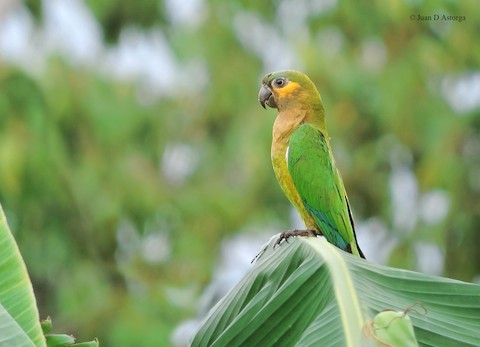
“Veraguan Parakeet”, E. p. ocularis, with atypically extensive orange extending down onto the cheek. (Las Pangas, Puntarenas, Costa Rica; January 5, 2018.) © Juan D. Astorga
Immatures are mostly green with olive face, throat, and chest, and a bold, complete whitish or grayish eyering. As they mature, the olive turns more grayish-brown overall and yellowish or orange around the eyes.
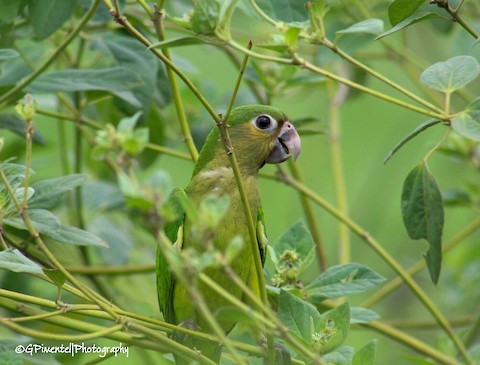
“Veraguan Parakeet”, E. p. ocularis, immature. (Las Tablas Abajo, Los Santos, Panama; June 15, 2019.) © Gumercindo Pimentel
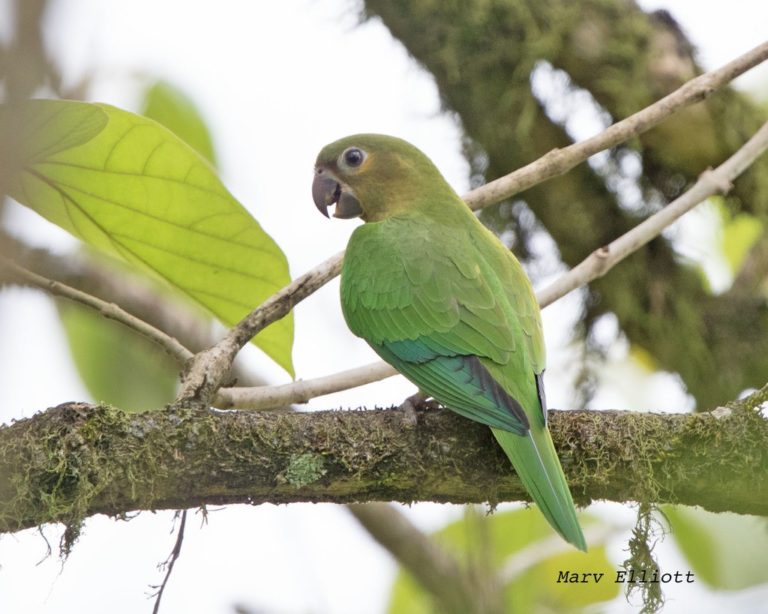
“Veraguan Parakeet”, E. p. ocularis, immature. (Puerto Amoroso, Puntarenas, Costa Rica; April 9, 2017.) © Marv Elliott
Notes
Monotypic form. One of four (or so) potentially distinct forms of Brown-throated Parakeet (pertinax).
For a discussion of the taxonomy of the Brown-throated Parakeet complex, see Distinguishing Features: Has the Diversity of Brown-throated Parakeets Been Overlooked?
See below for a comparison of “Veraguan Parakeet” with other forms of Brown-throated Parakeet.
Cf. Other Brown-throated Parakeets. The “Veraguan Parakeet” is a somewhat distinctive, isolated form of Brown-throated Parakeet—conceivably a separate species, although its plumage falls centrally within the broad, diverse spectrum of Brown-throated Parakeet plumages in South American and Caribbean populations. The only adjacent Brown throated population, the “Gray-throated Parakeet” (aeruginosa, as well as griseipecta if that is truly a valid subspecies) of northern Colombia, is a distinct form that is readily identifiable because it has an entirely gray-brown and scaly-textured face, throat, and chest, and a largely blue crown. Some of the more distant populations—especially chrysophrys of northern Brazil—resemble “Veraguan” in their facial patterns, but rarely show precisely the same combination of a broken eyering and orange crescent below and behind the eye.
Additional Photos of “Veraguan Parakeet”

“Veraguan Parakeet”, E. p. ocularis. (Corredores, Puntarenas, Costa Rica; July 27, 2019.) © Guillermo Saborío Vega

“Veraguan Parakeet”, E. p. ocularis, showing relatively little orange below the eye. (Sabanas de Coclé, Panama; February 3, 2018.) © Jan Cubilla
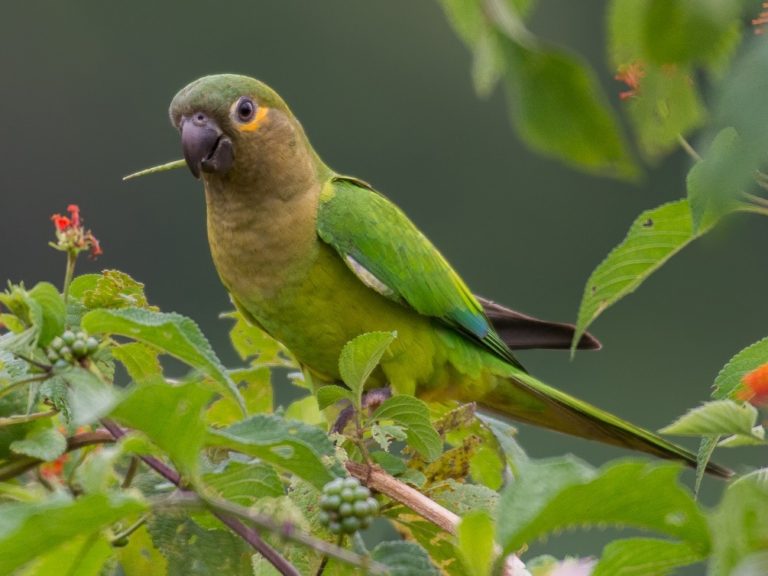
“Veraguan Parakeet”, E. p. ocularis. (Las Pangas, Puntarenas, Costa Rica; October 13, 2019.) © Daniel Hernández
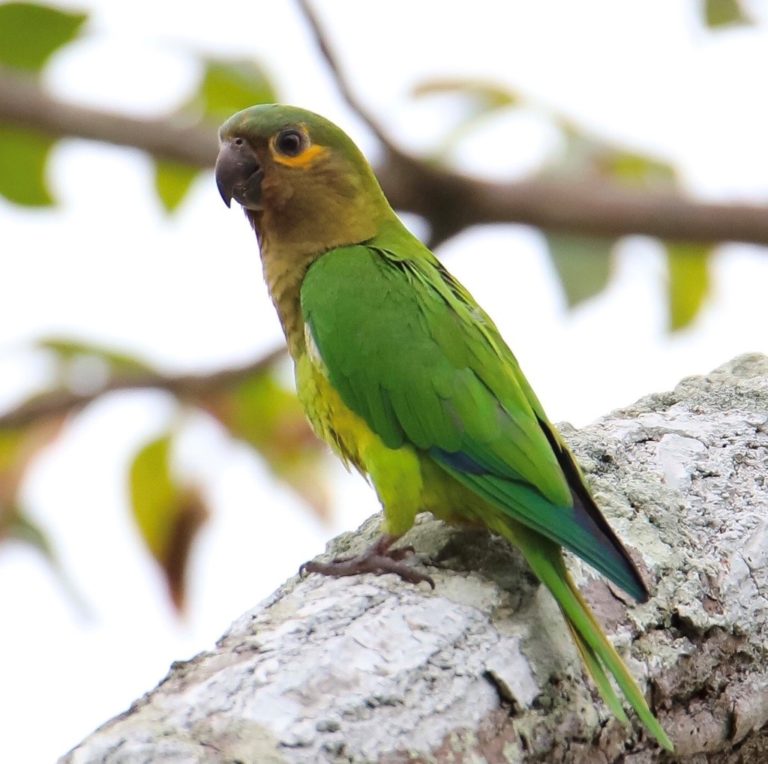
“Veraguan Parakeet”, E. p. ocularis. (Arraiján, Panama Province, Panama; December 20, 2020.) © Aitor

“Veraguan Parakeet”, E. p. ocularis. (Las Pangas, Puntarenas, Costa Rica; April 5, 2020.) © Daniel Hernández

“Veraguan Parakeet”, E. p. ocularis. (Las Pangas, Puntarenas, Costa Rica; April 5, 2020.) © Daniel Hernández
References
BirdLife International. 2018. Eupsittula pertinax. The IUCN Red List of Threatened Species 2018: e.T22685745A131917543. https://dx.doi.org/10.2305/IUCN.UK.2018-2.RLTS.T22685745A131917543.en. (Accessed August 16, 2021.)
eBird. 2021. eBird: An online database of bird distribution and abundance. Cornell Lab of Ornithology, Ithaca, N.Y. http://www.ebird.org. (Accessed August 16, 2021.)
Forshaw, J.M. 2010. Parrots of the World. Princeton University Press, Princeton, N.J.
Garrigues, R., and R. Dean. 2014. The Birds of Costa Rica: A Field Guide (Second Edition). Cornell University Press.
Juniper, T., and M. Parr. 1998. Parrots: A Guide to Parrots of the World. Yale University Press.
Ridgely, R.S., and J.A. Gwynne. 1989. A Guide to the Birds of Panama (Second Edition). Princeton University Press.
Stiles, F.G., A.F. Skutch, and D. Gardner. 1989. A Guide to the Birds of Costa Rica. Cornell University Press.
Xeno-Canto. 2021. Brown-throated Parakeet – Eupsittula pertinax. https://www.xeno-canto.org/species/Eupsittula-pertinax. (Accessed August 16, 2021.)

